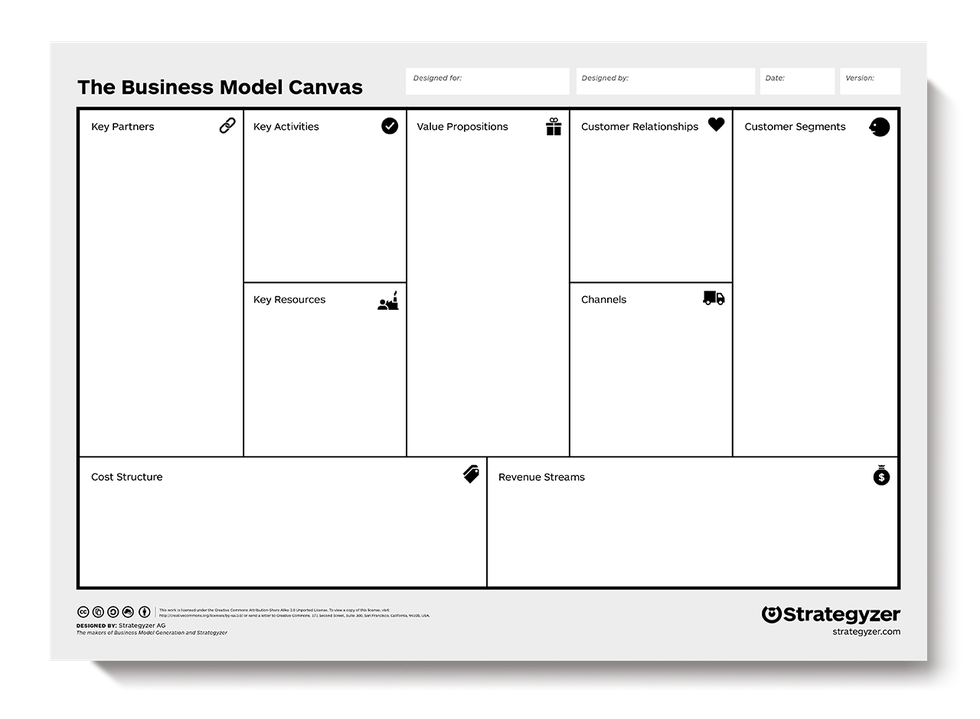What exactly is the Business Model Canvas?
The Business Model Canvas (BMC) is a beautifully constructed model created by the Swiss Alexander Osterwalder. This model, as represented in the chart below, creates a strategic, visual representation of all the components of a business. The canvas consists of nine rectangles, each representing a vital component of running a business: key partners, key activities, key resources, value propositions, customer relationships, channels, customer segments, cost structure and revenue streams. You may be wondering why a busy high school student is taking time to learn about a random business theory. Well, I came across the Business Model Canvas while researching business plans for personal endeavors. However, upon understanding the BCM, I realized the numerous similarities this process has with college admissions, one of the most excruciating processes of our lives.
How do the pieces of the canvas fit into your college application?
Part 1: Key Partners
BMC: Key partners for a business are the people without whom the business would not function, such as publicists, suppliers, or distributors.
College Admissions: Similarly, key partners in the context of college admissions keep the admissions process from crumbling. These partners can come in various forms: your parents, teachers, tutors, coaches and so on.
Part 2: Key Activities
BMC: What are the tasks that contribute to the success of the company? For example, filing your taxes on time or building a functioning website.
College Admissions: These, arguably, are the most important facet of college admissions, as they make up a bulk of your application. For instance, maintaining a high GPA or succeeding in a club.
Part 3: Key Resources
BMC: These items are the ones that allows your business to function more efficiently. For example, a printer and fax machine or a computer.
College Admissions: These resources all aid in strengthening the key activities. For example, AP review books or online resources like Khan Academy.
Part 4: Value Propositions
BMC: In business terms, a value proposition can be easily defined as what about your business brings value to the customer. For example, Uber. The way the brand works everyone involved is benefiting. Whether you are a driver, using your spare time to earn some extra money, or a passenger looking for a ride.
College Admissions: In terms of college admissions, your value proposition is what you bring to the college; in other words, why would they want you over the thousands of other applicants. Just as a business's value proposition comes in many forms, so can yours. For instance, you may be a bright young scientist, much like Sheldon Cooper, who can bring attention to the university in the future, given the right research facilities.
Part 5: Customer Relationships
BMC: In a business, the customer relationship is the one of the most important aspects in order to succeed. Building a relationship usually takes place differently in larger-scale and small-scale businesses. In a smaller, local business a customer relationship means things like knowing your regular customers personally. In larger companies, customer relationships usually take place in the form on rewards programs like Starbucks Rewards.
College Admissions: When applying for college, you rarely have a personal relationship with the college. However, certain relationships can be made in the form of personal contacts in the school's staff or networking with alumni.
Part 6: Channels
BMC: The channels in a business refer to the different ways a product reaches the customer. This could be a website, a physical store, or selling through media sources like TV.
College Admissions: While the most common channel to reach a college is the application, there are other ways. You could apply early admission, early decision or even get recruited for athletics.
Part 7: Customer Segments
BMC: A customer segment is the specific group of customers you are targeting. A business may only target one segment, or cater to various segments with various products or services. If we look at Uber again, they offer different services for different needs. UberX offers a ride in an everyday car with seating up to four people. On the other hand, Uber Black is their luxury service which sends a black SUV or luxury sedan with a professional driver for your ride.
College Admissions: A customer segment in terms of collge admissions would be the different types of colleges. For example, your application would be different when applying to a science based university such as Georgia Tech or MIT than if you were applying to an art school such as the Savannah College of Art and Design or the Rhode Island School of Design.
Part 8: Cost Structure
BMC: The cost structure includes all the costs that your business will incur. This includes anything from paying your employees to buying staples for your office.
College Admissions: When referring to college, the cost structure is the tuition and other costs for attending a said college. These costs include meal plans, textbooks, and other fees. These costs may also be reduced through financial aid.
Part 9: Revenue Streams
BMC: In a business, a revenue stream is the value the customer brings to the business; this usually means money. Start-ups tend to only have one revenue stream: by selling their products. But larger companies expand and tend to have multiple revenue streams: online sales, in-store sales, selling merchandise and so on.
College Admissions: Different colleges provide you with different "revenue streams" or values. These can come in the form of tangible benefits like resources at a college or intangible benefits such as contacts and a larger opportunity for networking.
What's the take-away?
Alexander Osterwalder created the Business Model Canvas to make the process of operating a business more streamlined. By using his nine components and adapting them to your own needs, you can easily discover the path that leads you to your dream school!






















